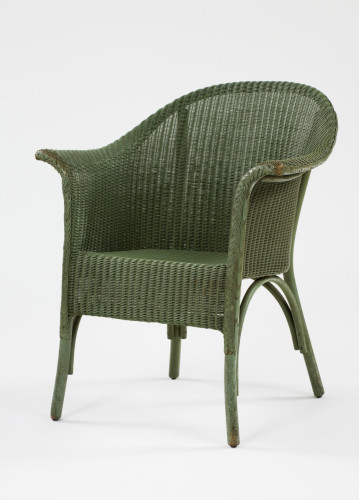41/1979
Collection
Furniture
Brief description
'Lloyd Loom' woven fibre chair in Naples green, Model 3, stamped 'CC41' and with a manufacturer's paper label, made by W. Lusty and Sons Ltd., Bromley-by-Bow, London, under the Utility Scheme, c.1947-1953.
Title
3
Object name
armchair
Object number
41/1979
Location
On Display
Production organisation
W. Lusty & Sons Ltd (manufacturer)
Production date
1945-1953 (manufactured)
Production place
Bromley-by-Bow (manufactured)
Period
Twentieth century (1900-1999)
Material
beech
paper
steel
paper
steel
Technique
bent
woven
nailed
woven
nailed
Physical description
'Lloyd Loom' woven fibre chair in Naples green, Utility Scheme Model No.3, 1947-1953, made by W. Lusty and Sons Ltd., Bromley-by-Bow, London, United Kingdom. Stamped 'CC41' and manufacturer's paper label on the inside of front horizontal rail.
Dimensions
Height: 78cm
Width: 67cm
Depth: 66cm
Width: 67cm
Depth: 66cm
Website keywords
seating
Label
Caption for Exploring 20th Century London website:
This chair was made by the firm W. Lusty & Sons in Bromley-by-Bow. Lusty's factory was near the Docklands which were a target of enemy bombing in the Second World War. The factory was destroyed by a bomb on 7 September 1940 at the start of the Blitz. It took five years for it to be rebuilt and this chair dates from the time when production started again. It is stamped with the mark CC41 which was applied to all furniture made during and straight after the War (1942-53) under the Government's Utility Scheme, which aimed to conserve resources and ensure a supply of furniture to those who needed it. The stamp proved the chair conformed to the scheme and meant the buyer did not have to pay tax on it.
This chair was made by the firm W. Lusty & Sons in Bromley-by-Bow. Lusty's factory was near the Docklands which were a target of enemy bombing in the Second World War. The factory was destroyed by a bomb on 7 September 1940 at the start of the Blitz. It took five years for it to be rebuilt and this chair dates from the time when production started again. It is stamped with the mark CC41 which was applied to all furniture made during and straight after the War (1942-53) under the Government's Utility Scheme, which aimed to conserve resources and ensure a supply of furniture to those who needed it. The stamp proved the chair conformed to the scheme and meant the buyer did not have to pay tax on it.












